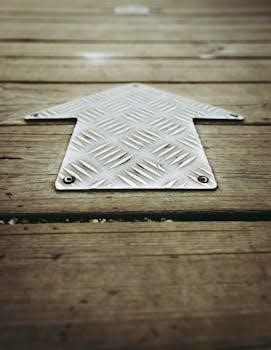Kreg Jig Screw Size Guide⁚ A Comprehensive Overview
Pocket-hole joinery’s popularity stems from its speed and strength․ Selecting the correct Kreg screw is vital for success․ This guide simplifies screw selection, focusing on length, type, and material thickness for robust joints․ Explore handy charts and expert tips․
Kreg pocket-hole joinery is a popular woodworking technique renowned for its speed, strength, and ease of use․ It offers an efficient alternative to traditional methods like mortise-and-tenon joints, often achieving comparable strength in a fraction of the time․ This method involves drilling an angled hole (the “pocket”) in one workpiece, which then allows you to drive a screw into an adjacent piece, creating a secure joint․
The Kreg Jig system simplifies this process, providing a user-friendly and precise way to create these pocket holes․ Its adaptability makes it suitable for various projects, from furniture building to cabinet making․ A key component of successful pocket-hole joinery lies in selecting the correct screw․
Using the wrong screw can compromise the joint’s integrity․ Factors like wood thickness and type are crucial considerations․ This guide will delve into these factors, providing you with the knowledge to choose the ideal Kreg screw for your project․ Understanding the nuances of Kreg screw selection is essential for achieving strong, durable, and aesthetically pleasing results in your woodworking endeavors․
Understanding Kreg Screw Types
Kreg screws aren’t a one-size-fits-all solution; they come in various types, each designed for specific applications and materials․ Knowing the differences between these types is crucial for achieving optimal results in your pocket-hole joinery projects․ Key distinctions lie in thread type (coarse vs․ fine), head style, and material/coating․

Coarse-threaded screws are generally used for softwoods, plywood, and MDF․ Their aggressive threads bite firmly into these less-dense materials, providing excellent holding power․ Fine-threaded screws, on the other hand, are designed for hardwoods․ Their finer threads prevent stripping in denser woods like oak, maple, or cherry․
Beyond thread type, Kreg offers different screw head styles, such as pan-head screws․ These are recommended for thinner materials․ Understanding these nuances allows you to select the screw that best matches your materials and project requirements․ Correct screw selection ensures a strong, reliable, and long-lasting joint, preventing issues like screw pull-out or joint failure․ This section will further explore these screw characteristics․
Factors Influencing Screw Selection⁚ Wood Thickness
Wood thickness plays a pivotal role in determining the correct Kreg screw length․ Selecting the appropriate screw length based on material thickness is critical for a strong and reliable joint․ Using screws that are too short will result in inadequate holding power, while screws that are too long can protrude through the material, creating an unsightly appearance and potentially compromising the joint’s integrity․
The general rule of thumb is to choose a screw length that allows the screw to penetrate about halfway into the receiving piece of wood; This ensures sufficient thread engagement for a secure hold without risking breakthrough․ Kreg provides handy charts and guidelines that correlate wood thickness to recommended screw lengths, simplifying the selection process․
For instance, when working with 1/2-inch (12mm) thick material, Kreg typically recommends a 1-inch screw․ For 3/4-inch material, a 1 1/4-inch screw is often the appropriate choice․ Always consult Kreg’s resources for specific recommendations based on your project’s needs․ Remember that if you join different thickness boards together, use settings of the thinner board․
Factors Influencing Screw Selection⁚ Wood Type (Hardwood vs․ Softwood)
The type of wood, specifically whether it is hardwood or softwood, significantly impacts Kreg screw selection․ Hardwoods, such as oak, maple, cherry, and ash, are denser and require screws with finer threads to prevent stripping․ Softwoods, including pine, fir, cedar, and plywood, benefit from coarser threads that grip the wood fibers more effectively․
Using the wrong thread type can lead to weak joints or difficulty driving the screws․ Coarse-threaded screws in hardwood can strip the wood, while fine-threaded screws in softwood may not provide adequate holding power․ Kreg offers specific screw types tailored to each wood category․
Always identify the wood you’re working with before choosing your screws․ If unsure, consult Kreg’s technical support․ Correctly matching the screw thread to the wood type ensures a strong, durable, and long-lasting joint․ Using the wrong type of screw can result in project failure․
Kreg Screw Length Chart⁚ A Practical Guide
Selecting the correct Kreg screw length is crucial for strong pocket-hole joints․ The primary factor determining screw length is the thickness of the material being joined․ A Kreg screw length chart serves as a practical guide, correlating material thickness with the appropriate screw length․ These charts typically list common material thicknesses and their corresponding recommended screw lengths․
For instance, a 1/2-inch thick board might require a 1-inch screw, while a 3/4-inch board may need a 1 1/4-inch screw․ The chart ensures the screw penetrates deep enough into the second workpiece for a secure hold without protruding through the other side․
Always consult a Kreg screw length chart before starting your project․ Ensure you measure your material thickness accurately․ When joining boards of different thicknesses, use the thinner board’s thickness to determine the screw length․ This approach guarantees optimal joint strength and prevents screw-related issues․
Kreg Screw Head Types and Their Applications
Kreg screws aren’t just about length and thread; the head type plays a crucial role in joint integrity․ Pan-head screws are commonly recommended for 1/2-inch thick material, offering a broad bearing surface․ This design prevents the screw from pulling through softer materials․ It distributes clamping force evenly․
Washer-head screws are another popular option, featuring an integrated washer․ This provides an even larger bearing surface, ideal for situations requiring maximum holding power․ They are often used with harder woods or when joining thicker materials․ The washer minimizes the risk of the screw head sinking into the wood․
Finally, there are also other types of Kreg screw heads, such as those used in the XL line of screws, with unique head designs optimized for use with the Kreg Jig XL․ Understanding these nuances allows for optimal screw selection․
Kreg XL Screws⁚ When and How to Use Them

Kreg XL screws are specifically designed for larger, heavier-duty projects․ These screws are thicker and longer than standard Kreg screws, providing exceptional holding power․ They are optimized for use with the Kreg Pocket-Hole Jig XL, ideal for joining 4x4s or thicker stock․ The XL screws offer incredible shear resistance․
When working with substantial materials, standard Kreg screws may lack the necessary strength and durability․ XL screws, typically available in 2 1/2-inch and 4-inch lengths, are crafted from hardened steel․ They provide a robust connection for projects demanding superior stability․
Using XL screws necessitates the Kreg XL pocket hole jig․ This jig creates larger pocket holes to accommodate the thicker screw shank․ Attempting to use XL screws with a standard jig can damage the jig and compromise the joint’s integrity․ Select the appropriate screw for the material thickness․
Kreg Screw Materials and Coatings

Kreg screws are manufactured from various materials and feature different coatings to suit diverse applications and environments․ The most common material is steel, chosen for its strength and durability․ However, the type of steel and the applied coating significantly impact the screw’s performance and resistance to corrosion․
Zinc-coated screws are a popular choice for indoor projects․ The zinc coating provides a basic level of protection against rust and corrosion․ For more demanding environments, such as outdoor projects or areas with high humidity, Protec-Kote™ screws are recommended․ This coating consists of three anti-corrosion layers․
Stainless steel screws offer the highest level of corrosion resistance․ They are ideal for marine applications or projects exposed to saltwater․ Selecting the appropriate material and coating ensures the longevity and integrity of the joint․

Consider the project’s intended use and environmental conditions to determine the best Kreg screw material and coating․
Troubleshooting Common Screw Selection Mistakes
Selecting the wrong Kreg screw can compromise the joint’s strength and longevity․ A common mistake is using screws that are too short, leading to insufficient holding power․ Ensure the screw penetrates deep enough into the thicker material for a secure connection․ Conversely, screws that are too long can protrude through the material, creating an unsightly appearance and potential safety hazard․ Always double-check the screw length against the material thickness before assembly․
Another frequent error is using the incorrect thread type․ Fine-threaded screws are designed for hardwoods, while coarse-threaded screws are better suited for softwoods and plywood․ Using the wrong thread type can result in stripped threads and a weakened joint․
Failing to consider the environment can also lead to problems․ Using zinc-coated screws in outdoor applications will result in corrosion and eventual joint failure․ Opt for Protec-Kote™ or stainless steel screws for exterior projects․ Addressing these common mistakes ensures strong and durable pocket-hole joints;
Where to Find Kreg Screw Size Information and Support
Finding the right Kreg screw size is easy with the wealth of resources available․ The official Kreg website is a prime source, offering detailed screw charts and a screw selector tool․ This tool guides you based on material thickness and type, ensuring accurate selection․
Kreg also provides comprehensive product manuals and support pages with frequently asked questions․ These resources cover various screw types, sizes, and applications․ For personalized assistance, Kreg’s technical support team is available via phone and email․
Retailers selling Kreg products often have knowledgeable staff who can assist with screw selection․ Online woodworking forums and communities offer a platform for sharing experiences and seeking advice from fellow woodworkers․ Kreg’s YouTube channel features instructional videos demonstrating screw selection techniques․
Consulting these resources guarantees you’ll choose the optimal Kreg screw for your project, ensuring robust and long-lasting pocket-hole joints․ Always double-check your selections before committing to a purchase․
